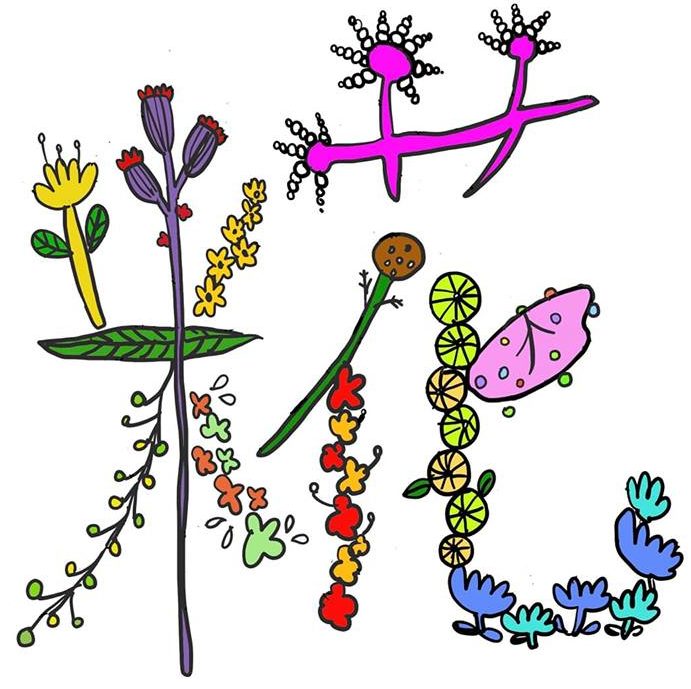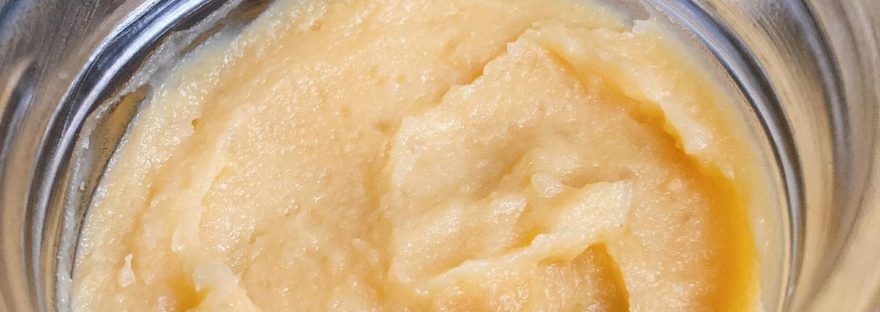7月、8月は麹アドバイザーの年間プログラムも夏休み中。 ・・と言うことで、穏やかに夏を楽しむつもりだったのですが・・・ いや、ちょこちょこ楽しんではいますが。 実は私の心の中は相当どんちゃん騒ぎな状態が続いております。 鍼灸の方がこの冬に忙しすぎた経験を踏まえて、夏の間に余裕ができている今、麹の方の何かをしないと!と(あせって)動いていました。 自分の方向性、自分のやりたいこと、何が自分に足りていないのかお金のこと、時間の事。 まあ、色々まとめると、 結果、 当たって砕けてみる事にしました(笑) とりあえず色々やってみて、ダメだったらそこで考える。後もう一つ、これは大きな決断でした。 ぜひとも自ら、恥をかきにいこう!(ライブ配信の話ですね。いやそれだけでもないか。) 自分を出すって恥ずかしいです。みっともない姿になるかもって思ったら、震えきちゃいますよね。もう年もとってきたしさー(今更?)でも、それをあえてみんなに見せる方向で行こうと決めた、この7月8月。 とにかく!金山寺味噌やろうかなと思いついたのが7月だったにもかかわらず、こんなにも告知が遅れてしまいましたと言う前おきが長くなってしまいました。 どれだけの方が参加してくださるかわかりませんが、とりあえずやってみます。一つのプレゼント企画として、今年この機会をミスったとしても来年また挑戦できればいいね、と言う感じで。後、この形での企画なら、この時期過ぎても申し込みをして自分でいつでも挑戦できるかなと。 以前、私は麹アドバイザーの2年目のコースの一つとして、金山寺味噌を3月に開催しました。その時にどうして冬にやるの?夏まで待てばいいじゃない、金山寺味噌は夏にやらないと意味がないのよと言われていました。 なんで3月に金山寺味噌をやるの? 私がやりたいから! それだけの理由だったのですが、人に何かを止められる、ハードルを与えられるって、 めちゃくちゃ良い機会になるんですよ。それを乗り越えようとするから。 私もその時に相当色々考えて、リサーチして、 私なりの「金山寺味噌というトピックを利用して発酵を人に伝える」方法を完成させました。 結局麹アドバイザー2年目のコースの一つとしての金山寺味噌は、金山寺味噌ではなく、「なめ味噌」としての会としてまとめて、 そんな「金山寺味噌はこうあるべきだ」的な内容も含めながら、もっと広い意味での「なめ味噌の定義」をお伝えできる、 私としては大満足の内容を作る事ができました🎵 ここまでの結果を出すために導いてくださった皆様方に心から感謝しております。 そして今回の無料企画。 この「なめ味噌の会」の、一部である「金山寺味噌」を、仕込むのに理想的な暑い夏に開催する事にした、のであります。 金山寺味噌というのは、本来れっきとした定義があります。 それは「紀州金山寺味噌」といい、和歌山県でGI(地理的表示)認定を受けているものです。 今回作るものがいかにそれとは違うものなのか、それがどう言う意味なのか、そんな事も交えて進めていきたいと思います。 インスタでライブ配信をすると言うのが究極に苦手で(英語の話)何日もカメラの前に座って固まるだけで終わってしまったり、何度も練習してみたんだけど全然英語がまとまらなかったり、最後の最後に勢いでやったライブは撃沈でした・・・(やっぱり英語の話)その後に日本語でライブ配信もやりましたが、こちらにて今月のお知らせ3つをお伝えしています。 https://www.instagram.com/reel/CwMD0wkqczW/ ======= お申し込みはこちらから↓ https://onlineschool.kojiflower.com/kinzanji-miso-event 基本は英語の記事にて進めていきます。最後のZoomでは日本語の会と英語の会を分けようと思っています。 オンラインにて、作り方とレシピを公開して、自分たちで作ってもらう。 でもせっかくの企画なので皆さんにお会いしたい!お話したい!と言う事で、Zoom Meeting を設定しました。 日本語開催はこちら: 2023年8月26日(土)午後9時ー(北米東部時間)(ちなみに英語の開催は同日の午後7時からとなります) 実はね・・これからコンテンツ作るの(汗でもきっと大丈夫。何をどう見せるか、どう言う順番でやるかはもう一度やってるから。ここまでの道のり(LP作成とかフォーム作成とか、日本語と英語とか)が結構大変だったからー。 とにかく皆様、ご登録だけ先によろしくお願いします。こちらから!https://onlineschool.kojiflower.com/kinzanji-miso-event追って情報流していきますー!そして可能であれば、今週土曜日8月26日の午後9時より(北米東部時間です) 皆様にお会いできるのを、楽しみにしています。 2023年8月21日 しおりでした。
Category: Upcoming Workshop
(Free event)Mason Jar Nukazuke
(日本語は英語の下にあります)This famous traditional tsukemono is pretty difficult.We’ll, it’s not difficult, the process is pretty simple…but so hard to continue, and it give us a lot of pressure like we need to mix it well everyday, or feel like I’m not good wife/mother/lady when it goes bad… Anyway, this is true that the taste of Nukazuke… Continue reading (Free event)Mason Jar Nukazuke
Free Mugi(barley) Miso Making Event
Good evening everyone. Today, I would like to invite you all to the free barley miso making event! Last year we held a free doburoku making event here at the Japanese Koji Fermentation Village. If you go to our past post, you can find the information. Please check it out if you’re interested. We wanted… Continue reading Free Mugi(barley) Miso Making Event
Koji Flower 年間プログラムを取る最後のチャンス
おうちクリニックの10月、産前産後でもお話を出したのですが、 実はわたくし、2022年3月にて年間プログラムを提供するのを終了させていただきます。 理由は、鍼灸の活動に影響が出てきてしまいまして・・・ これからは、麹アドバイザーが麹に関する事は世に広めてくれるでしょう。私は、私のできる事、心が向くことをもっと広げていきます。 おうちクリニックでやっているような内容、これが私にできる事であれば、こちらをもっと充実させる事も必要だなとは思っています。 完全に麹を辞めるつもりは全くありません。情報はこれからも配信していきます。いつまでも「麹の人」でいたいと思っています。健康を語るのに、麹なしでは語れない位、私の一部です。 そして、これが最後の募集になります。今から(11月から)来年の3月までの5ヶ月間にて、わたしくしおりと一緒に麹の活動をする事に興味がある方がもしいらっしゃれば、 ぜひ今から年間メンバーにお申し込みしてみませんか? ー1年分のプログラムは動画にて視聴可能です。(今までの動画が全部見れます) ー2022年12月までは、私がサポート致します。 ただ、毎週のように行われていたZoomが3月で終了するのみで、 みんなでコミュニケーションを取りながら各自が学んでいくのですが、情報はシェアしながら一緒に学んでいく、 今のスタイルは2022年12月まで続きます。ー1月から3月は、基本の作り方からちょっと外れて、 西京味噌 八丁(風)味噌 玄米味噌(玄米麹) 金山寺味噌 なども予定しています。ー全く初めての方でも大丈夫ですし、 すでに製麴に馴染みがある方でも大丈夫です。 ー米麹酵母を使ったパンや豆腐よう作り、柿酢作りなども、 メンバー間で自然派生して開催したりしました。ーおうちクリニックも、2021年1月から全部視聴可能です。ー年間メンバー費は、 $900/年 $80/月 となります。ご興味ある方、ぜひご連絡お待ちしています。 お問い合わせはこちらから . 年間メンバーのお申し込みショッピングカートはこちらから https://kojiflower.eeeagency.com/product/nenkanlast/
今月は製麴の会です!
皆さんこんにちわ!チョット蒸し暑いトロントよりしおりです。 とはいえ現在の温度23度。蒸し暑いとか言ってたら怒られちゃいますね。さて、プライベートではなんと3人の息子たちのうち、2人が旦那と一緒に日本! という、人生初の「次男との2人くらし」という めちゃくちゃらくーーーな生活を満喫しております。 長いこと子供と一緒にワチャワチャしておりましたので、ふと気づくことなど沢山あり、なんだか毎日ウキウキワクワク状態で仕方ありません。 皆さんも忙しいときはその場を離れて一度自分を取り戻しては? ・・・・なんてアドバイスがこういう場合は合うのでしょうが、私はどちらかと言うと自分の過去でそんな事が出来なかったのであえてそんな事いいません。 ただ、今の状況って、絶対そのうち変わるから。今と一緒って、絶対にないから。今って、そのわちゃわちゃでぐちゃぐちゃの今って、今だからできるんだよって。だから今のその状態で、それでいいんだよって。大丈夫よ♪って それしか言えません〜。そう、皆公平に、年をとる(爆)さて、Koji Flower7月は、いよいよ米麹の製麴が始まります(ました)ぼちぼち始まっています。そこで、今日製麴の会にアップした内容を、こちらにもシェアしてみたいと思います。これからの変化に、自分で自分に頑張るぞと喝を入れるという意味も含めて…++++++ #2021July おはようございます。 ずーーーっと、今回の製麴の会をどのように進めているか 悩んでいます。 が。 ふと昨日思いついた方法にて・・・ 日にちを分けて、 ちょこっとづつ、 情報を提供していってみようかなーというもの。 忙しい皆さんでも、 ほんの一日数分だけでも目を通す、耳で聞く、文章を読む事により、そのうちなんとなく製麴出来る方法が頭に残っていけるような方法って良いかもしれない?!と、思いつきました。 Zoomレクチャーはするのですが、同じ説明を毎回するのではなく、今までとは違った使い方をしたいなと。 今までのZoomレクチャーまでの情報は、細かく分けることによって事前に学べるようにすると有効的かなと。Zoomで実際に会ってお話するというのは…一期一会、その時その場所に居た皆だからこそ学びあえ、シェアできるような時間にしたいなと思っています。 米麹製麴のビデオなんて、Youtubeで検索したら山のように出てくると思うんです。その中で、私が提供する会として、私らしい特徴を出してみたいなって、 思っています。 まずは動画を作ること。 今回初めて参加の方はびっくりするかもしれませんが、実は私はあまりビジュアルから入ることをあえてしなかったので、今までちゃんと製麴している所を見せてくることはしてこなかったのです。 それは、方法が一つではないから。見ると、そうしなくてはならないと思いこんでしまうから。 皆さんなりに、皆さんの周りを見渡して 想像力を使って取り組んでもらいたいという願いがありました。そして、ヒントしかない分、必死に答えを探そうと動き始める。そこに他の皆さんとのコミュニケーションが生まれる(お互い質問し合ったりする事)、この方法がとっても気に入っていました。 が、ここで少し方向性を変え、動画を加えながらどうやったら今1番新しい情報を与えることが出来るかと言うのを少し考えています。そして、この動画作成の重要さを、将来的な進め方としてやはり私にとって大きな大きなスキルになるのだろうなと思っています。セルフラーニングが可能な方法を、探っています。 まだまだビデオ作成は初心者なので多めに見てやってくださいね。今回、ビデオをお見せしながらそれを元にあーでもない、こーでもないとお話を進めていけるようなそんな感じになっていけばいいなーッて思っています。 とまあ、長くなってしまっては意味がないので、 今日はこの辺りで!しおりでした。++++++ Koji Flowerで開催中の米麹製麴の会、まだまだ今からでも参加可能です。ググっても、Youtubeを見ても、本を見ても、道具を買い揃えても、なんだかまだ自分では出来ない!という方もWelcome自分のやっている製麴が正解なのかどうかもわからない、もっと製麴に応用力をつけてみたい、もっと違う世界を見てみたい!そんな方は是非♪https://kojiflower.eeeagency.com/product/komekojinokai/お申し込みはこちらから!しおりでした。 Koji Flowerkojiflowershiori@gmail.comhttps://kojiflower.eeeagency.comhttps://www.facebook.com/kojiflower/https://www.instagram.com/kojiflowershiori/ The Centre for Japanese Acupuncturehttp://centreforjapaneseacupuncture.ca/
参加者の声・Voice from Yearly Member
(English below)年間メンバーに、この3月から入ってきてくださった方の感想です。1月からスタートだった年間スケジュールですが、すでに何度も白味噌は作ったことがあったし、簡単どぶろくもすぐに出来るし・・と、一気に飛ばして全部追いついてもらった1ヶ月だったのもあり、プラス3月4月はイベント続きて相当大変だったでしょう。でも、それを超えてこのような感想が頂けたこと、嬉しく思います。今月は菩提酛を丁寧に、来月は米麹を作る会、その後年末までゆっくりじっくり取り組んでもらいたいと思います。+++入会して1か月、怒涛のようにあっという間に過ぎた、というのが正直な感想です。 最初はみりん仕込みがきっかけで参加させていただき、結局年間メンバーとして麹について1年勉強することにしました。 良かったことは麹や各調味料の作り方をただ教わるのではなく、その歴史や成り立ち、地域による違いなどそれにまつわる様々な知識を興味深く学ぶことが出来るところです。 麹だけでなく、食育や東洋医学を基礎としたおうちでのケアなど、毎月2,3回、色々なトピックで講習があり、多岐にわたって学ぶ機会があるのも楽しいです。スケジュールが重なる場合は毎週?数日おきに連続ということもあり当初は面食らいましたが(笑)一緒に学ぶメンバー達も経験豊富な方々から様々な分野に造詣の深い方など、チャットでのやり取りも活発でほう!へえ~!と、毎日、目から鱗の情報が飛び交うのも新鮮です。 オンライン講習後の実習は個人作業になるものの、疑問点や相談はしおりさんがすぐに対応してくださり一緒に考え適切な助言をくれますし、チャットグループでの共有・アドバイス体制も万全で安心しています。 しおりさんのスタイルで一番印象的なことは、麹の声に耳を澄ます・仕込んだ調味料と会話をするつもりで向き合うことをいつもリマインドされていることです。 問題に直面した時に解決策や答えを教えることは簡単ですが、住む地域や環境も様々な中麹の変容の仕方もそれぞれであること、一人ひとりの置かれた状況の中で起きている事象をそれぞれが考え、答えを見つけ出せるようなフォローが素晴らしいなといつも思います。 目の前の麹と対話し、尊重し、どうしてほしいか相手を思って想像する。これって人間関係と同じだなと思いますし、麹は生き物だということを日々の活動を通し改めて実感しています。 仕込んだみりんや醤油を毎日眺め手をかけながら、Koji Lifeを楽しんでいます。 ++++Koji Flower -The Koji Academy- 5月の菩提酛、現在開催中。日本語と英語が飛び交いながら、皆で真剣に取り組み中。おうちクリニックは5月20日。頭痛についてのお話を予定しています。6月はいよいよ。。。米麹の製麴やります〜!米麹の製麴だけでもクラス取ってみたい方、是非お問い合わせ下さいね。kojiflowershiori@gmail.comしおりでした。 +++++ Here is a voice from a new member who joined us this March.The Yearly program has been started in January, but she has already made white miso many times before, and making doburoku is quite quick and easy,… Continue reading 参加者の声・Voice from Yearly Member
お醤油絞りました。
2020年に仕込んだお醤油を、今回絞ってみました。 今まで何度か絞ってきましたが、いつもは少しづつ、使う分だけしかも微生物の生きた生醤油の状態で少しづつ消費していけばいいじゃないのって思っていたし。火入れも水を加えるのも、そんなことしたら全部蒸発しちゃわない?って量だったし。 お醤油絞りに関しては、事前に何年かかけて(なかなか実行に移すのに時間かかるよね。。。)他の皆さんの方法をたくさん拝見させていただきながら、うーん、これならできるかな?えーこれ私買うのー?うーん。 と、想像をめぐらせていましたが。+++++今回のお醤油絞り。生醤油もいいけど、やっぱり火入れしてみよう!と、初めて火入れした醤油は。やーん。めっちゃ美味しいー!生醤油ともまたぜんっぜん違うー!それから、うどんにかけたり納豆に絡ませたり卵にかけたりもう、いつもそばに置いて何にでもかけてみるんだけど・・おいしー♪あと思ったのが。一度使ったコーヒーフィルター。これって結構染み込むんだよね。お醤油が。お醤油を絞るたび、これを毎回生産して捨ててしまうのはもったいないなー。と思い、 よし、じゃあもうこれ全部一気に絞っちゃえ!と意を結しました。(他にでっかいボトルに3本位仕込んでいるお醤油のストックあるし) この過程がね。なーんだ。あんなに事前に想像させてもらったのとは 全然裏腹に、 結構簡単にできるんじゃーん。というのが率直な感想。めちゃくちゃ大変だと思っていたもので。この出来上がる過程。 ふんわりと漂ってくるお醤油の香り、 火を入れるときのお醤油の変化 ぽたん、ぽたんという音の合唱 2箇所で作業してたから、2つの音が重なってとても可愛い♪コーヒフィルターに残った、おりの表情 出てきたお醤油のこの色。どれもこれもなんだか愛おしくて、この作業がとても楽しかったです。一つの瓶から、こんなにいろんな表情のモノが出てくるんだなぁって。 私はケチだから(笑)例えば一度使ったざるなんかを、少量の水でざっと洗い流し、その水を貯めて他の器具もざっと洗い流し、そのうち濃くなってきたその液体を、昨晩の残りのお鍋にザブンして昨晩は寝てしまいました。一応その後火にかけたつもりだったんだけど・・沸騰はしてなかったのか?! 朝はちょっと時間なくそのまま家を出たのですが、帰ってきて蓋を開けると・・・お鍋の中がぶっくぶくしてて。。。(爆ぎゃー!なんじゃこりゃぁーって感じ。 「昨日のお鍋の残りでお汁作って飲まなかたの?」って息子達に聞いてみたら、 「うん、開けたんだけど、ぶくぶくして脂も浮いてるし、気持ち悪くてすぐに閉めちゃった」ですって。ガハハ。そして、そのまま火を入れることなく夕方まで放置だったので、発酵はどんどん進み、私が帰ってくる頃にはぶっくぶくの、味見するとちょっと酸っぱみの出てきているものになっていましたとさ。でも、ご安心あれ。しっかり沸騰させて新しくお野菜もうどんも入れると美味しい味に大変身。もちろん全部完食でした。その時にもこのお醤油が大活躍ー!完成したお鍋の具材を各自お椀に取り、味付けはこの醤油のみ。すでに野菜やお肉の出汁が効いていたから、まあ美味しいこと。 ++++ 現在、お醤油プロジェクトには40名くらい参加してくださっています。多分みんな、なんだかこのどろどろした液体は本当にお醤油になるのか?! って思っているかもしれません(笑) これから、他の人がしぼり始めたレポートを見て、自分のお醤油の瓶を見つめ、きっとある日。意を決して絞ろう!と行動するんでしょうね。行動に移すって結構なエネルギー。これってみんな一緒だからそんな気になれる。みんなで一緒に作る、大きな醍醐味。そして、そんなみんなから、グループページからたくさんのおいしーすごいーたのしーの声が聞こえてくるのを、楽しみにしています。(なんだか私の、変な味かも・・というのも同時にお待ちしていますよ。。笑これも一緒に解決していこう!一人じゃないから怖くないっ!)そして、これから、この春からお醤油プロジェクト新規メンバーを募集します。3月27日にZoomレクチャーも開催します。醤油麹が送れそうであれば遠方からでもご参加可能です。(カナダ国内か日本!)是非、みんなで一緒にまた1年間。お醤油を見守っていきませんか?トロント(トロント市内各所、リッチモンドヒル、オークビル)バンクーバー九州に、現在アドバンスメンバーが存在しています。お近くの方、各アドバンスメンバーが醤油麹を作ってくれるし、お世話してくれます。現在、なんでも手に入れることのできるAmazonでもEbayでも醤油用の麹を売っているところはありません。作ってくれる人がいるというだけで、幸せですね。お醤油は手入れをしなくてはいけないので、みんなで一緒にリマインドしながらお醤油を混ぜていきます。お醤油についての知識も学びながら、1年間一緒に育てていきます。一度グループに入った方は、翌年からの更新は、お醤油用麹を買ってくだされば、そのまま引き続きグループページに滞在可能です。ぜひご一緒しませんか?お申し込みは、こちらのページより。https://kojiflower.eeeagency.com/product/syoyu2021/
Koji Flower- Koji Advisor Training Program
-Learning Koji and Beyond-The koji advisor training program is for -Want to learn about koji in a comprehensive program-Want to start koji business in a future-Want to inherit koji culture, Japanese culture-Want to learn about our health, body and mind with koji-Are interested in the oriental medicine approach-Want to learn how to use koji for… Continue reading Koji Flower- Koji Advisor Training Program
2021年度Koji Flowerオンラインクラスの予定
2021年度年間登録オンラインクラスの予定 年間登録メンバー(1年目) 1/21 基本の白味噌 2/25 簡単どぶろく(+白味噌オープン) 3/04 醤油レクチャ、赤味噌仕込み 4/08 味醂仕込み 5/06 菩提酛 6/10 米麹作りー製麹 7月中 課題―プレゼンかレポート 8/26 醤油用麹ー製麹 9/09 味醂レクチャー 10/07 麦麹の製麹からの麦味噌 11/04 豆麹の製麹 /金山寺味噌 12/02 おせち/赤味噌open アドバンス(2年目)1年目のクラスも取りながら、以下の予定も1月 京風白味噌仕込み2月 ↑Zoomレクチャー 3月 玄米麹 4月 天然酵母 5月 (菩提酛) 6月 (米麹) 7月中 課題―プレゼンかレポート 8月 白醤油(小麦製麹)9月 (味醂) 10月 (麦)八丁味噌11月 Hidamari Holiday Market/甘酒12月 (豆) ☆1年目のクラスは、一般の方の個別参加も可能です($60)☆2年目以降のクラスを取りたい方は、お問い合わせ下さい 2021年度 おうちクリニックの大まかな内容 おうちクリニックは基本アドバンス用のクラスとして設定しましたが、今年は初の試みですし、2021年度年間登録された皆さんもご参加頂けます。 1/03 午後9時~ 基本となるからだの使い方2/11 腸3/18 Diet、食事療法(陰陽五行4/22 ファスティング5/20 頭痛6/24 未病体7/22 熱8/19 食欲9/23 産前産後10/21 更年期11/18 睡眠12/9 風邪 ☆どの回も、一般の方でもご参加可能です($35)☆おうちクリニックとは、自分の家族が自分で守れるよう、おうちがそのままクリニックになれるように、麹を生活の中に取り入れながらからだの事、セフルケアについて学ぶ場所です。 年間メンバーについてはこちら
西京味噌の会も進行中/Saikyo Miso
I also run Saikyo-miso (Kyoto style very sweet miso) this month (in Japanese) Saikyo miso was born in Kyoto, and pretty special as it's really sweet, very white and creamy, and beautiful miso. The artisan of Saikyo miso put unbelievably lots of effort to make this kind of miso. In Japan, there are lots of… Continue reading 西京味噌の会も進行中/Saikyo Miso








